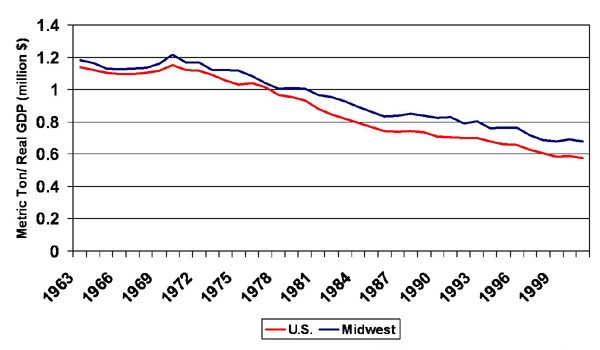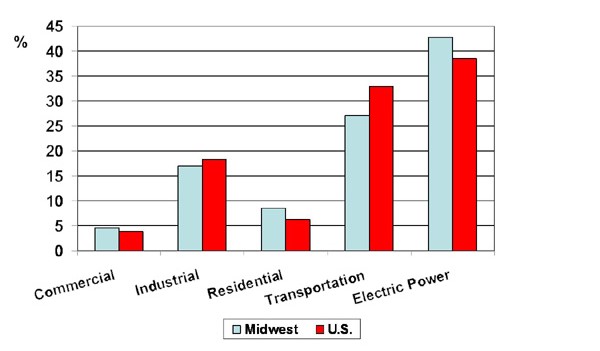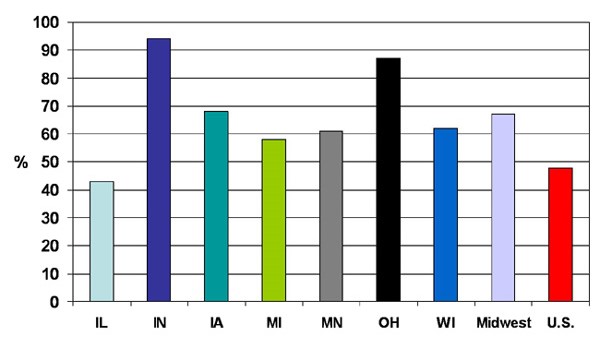The Midwest and the regulation of greenhouse gas
After years of inactivity in regulating so-called greenhouse gases (GHGs), U.S. policy may be on the verge of doing so. In April 2007, the U.S. Supreme Court ruled that the federal government was authorized to regulate GHG emissions from human activity, which some believe accelerate warming of the earth’s atmosphere, causing disruptive and costly climate changes. Carbon dioxide is the major source of such GHG emissions, making up 75–80 percent of the total volume. This fall, the U.S. Congress is expected to consider bills to control GHGs. Regionally, state and local governments are already acting to reduce GHGs or curb their growth. Most notably, California proposes to reduce emissions by one-third from 2004 levels by 2020. According to this plan, such reductions will be achieved by requiring more fuel-efficient cars and buildings and by requiring that the state’s electricity is generated from renewable energy sources and less carbon-intensive fuels.
Costs are an important consideration in choosing among the various ways to reduce GHG emissions. For this reason, some U.S. and global regions are choosing to set up or participate in “cap-and-trade” systems for GHG emissions, which will function like markets. Some private companies have also chosen to participate in cap-and-trade systems, such as the Chicago Climate Exchange=. In these systems, the total allowable amount of GHG emissions is capped. Each participant is awarded or sold permits, or “allowances,” to release specified amounts of GHG into the atmosphere such that the total permitted GHG by all participants does not exceed an overall cap. In limiting emissions in this way, cost savings accrue from the ability of permit holders to buy and sell their allowances with other participants. Those who can manage to reduce their needs for permits can sell them to others; those who cannot manage must purchase permits. In cap-and-trade systems, there are strong incentives for participants to manage and conserve emissions, since doing so generates cost savings. More importantly, cap-and-trade participants are motivated to come up with emission-conserving technological innovations. Seven governors of the Northeast are moving their states toward a “Regional Greenhouse Gas Initiative,” which will cap carbon emissions from the region’s electric power producers.
Market-based systems such as these can be important to regions in keeping down the costs and impact of mandated reductions of GHG emissions. How will the Midwest adapt to the regulation of GHGs? The Midwest economy will likely be affected by carbon regulation in two major ways, both of which will be addressed at a Chicago Fed conference to be held at the Detroit Branch on October 15. The first avenue of regional impact concerns the degree of direct carbon reduction that may be required of Midwest households and businesses, especially in the generation and use of electric power. A second avenue of impact is less direct. The U.S. Congress is considering greater stringency in the fuel-efficiency of cars, trucks, and other transportation vehicles. Major automotive companies are domiciled in the region, many of which are now financially beleaguered and many of which are thought to face added challenges in complying with heightened fuel-efficiency standards.
Emissions of carbon dioxide have been climbing over time in the Midwest and in the U.S. as a whole. Generally, carbon dioxide is released along with the burning of fossil fuels—coal, petroleum, and natural gas materials. Over time, our growing energy-hungry economy has burned more fuel. Since 1950, U.S. energy consumption is up over three fold, almost entirely from greater consumption of fossil fuels.
U.S. carbon emissions continue to lead the world (China is second), and U.S. carbon emissions have grown more rapidly than the nation’s overall energy consumption. Electric power generation is the source of the more rapid rise in carbon emissions. Among major energy-consuming sectors of the U.S. economy, electric power generation has outpaced the others. The burning of coal remains the primary means to generate electric power, and it is the most carbon-intensive fuel.
Despite rising emissions, the overall carbon intensity of the Midwest economy and the U.S. economy has been falling rapidly along with heightened overall energy efficiency. Over time, the U.S. economy can produce a dollar of real output with less energy input. As shown below, carbon dioxide emissions per dollar of real output are approximately one-half of what they were in the early 1960s. By this measure, the Midwest carbon intensity exceeded the nation by 17.8 percent in year 2001 versus an excess of 4.1 percent in 1963.
1. Total CO2 emissions per real GDP (2000 dollars, 1963-2001)

Surprisingly, it is not the Midwest economy’s greater concentration in heavy industry that explains its greater carbon intensity—at least not directly. The figure below reports that the region’s industrial sector accounts for a lesser share of its overall carbon emissions versus the nation’s in its overall emissions. Rather, the region’s electric power sector makes up a larger share of carbon emissions versus that of the U.S., a 42.8 percent share in the Midwest versus 38.4 percent for the nation.
2. 2004 CO2 emissions by major sector — Midwest vs. U.S.

Nor is it the case that the region’s residents consume considerably more electric power than the national average. Rather, the means of power generation in the Midwest tends toward the burning of coal along with attendant carbon emissions. As shown below, power generation facilities in every Midwest state (save Illinois) burn coal to a greater degree than those of the nation, a 41 percent greater share in May 2007. Illinois’ lower carbon intensity derives from its use of nuclear facilities to generate electric power. Indiana and Ohio are especially dependent on coal to generate power at the present time.
3. Share of electric power generation from coal (percent)

Source: Electric Power Monthly (EIA)
From these cursory observations, it would appear that, to avoid costs and penalties, the Midwest’s electric power generators would be called on to reduce carbon emissions in the event that state or national policies begin to control GHG emissions. Possible avenues to do so are to rely on more (carbon-free) nuclear generating plants or on renewable means, such as the conversion of wind power to electricity. Various technologies to scrub coal of its carbon are also available or on the drawing board.
In choosing among these vehicles to reduce carbon, cap-and-trade systems are in some respects highly suitable for electric power producers. Electric power plants tend to be large and fixed in number. Accordingly, the issuance, monitoring, and trading of emissions permits can be carried out with little monitoring and administrative cost. Of course, the ultimate costs of achieving carbon reductions remain uncertain. In the 1990s, the nation had favorable experiences with a cap-and-trade market among power producers in reducing sulfur dioxide emissions as required under the Clean Air Act. Emissions were reduced below expectations at costs that were far below expectations. It is hoped that a similarly successful marriage of technological progress and market-based incentives will once again come about.








